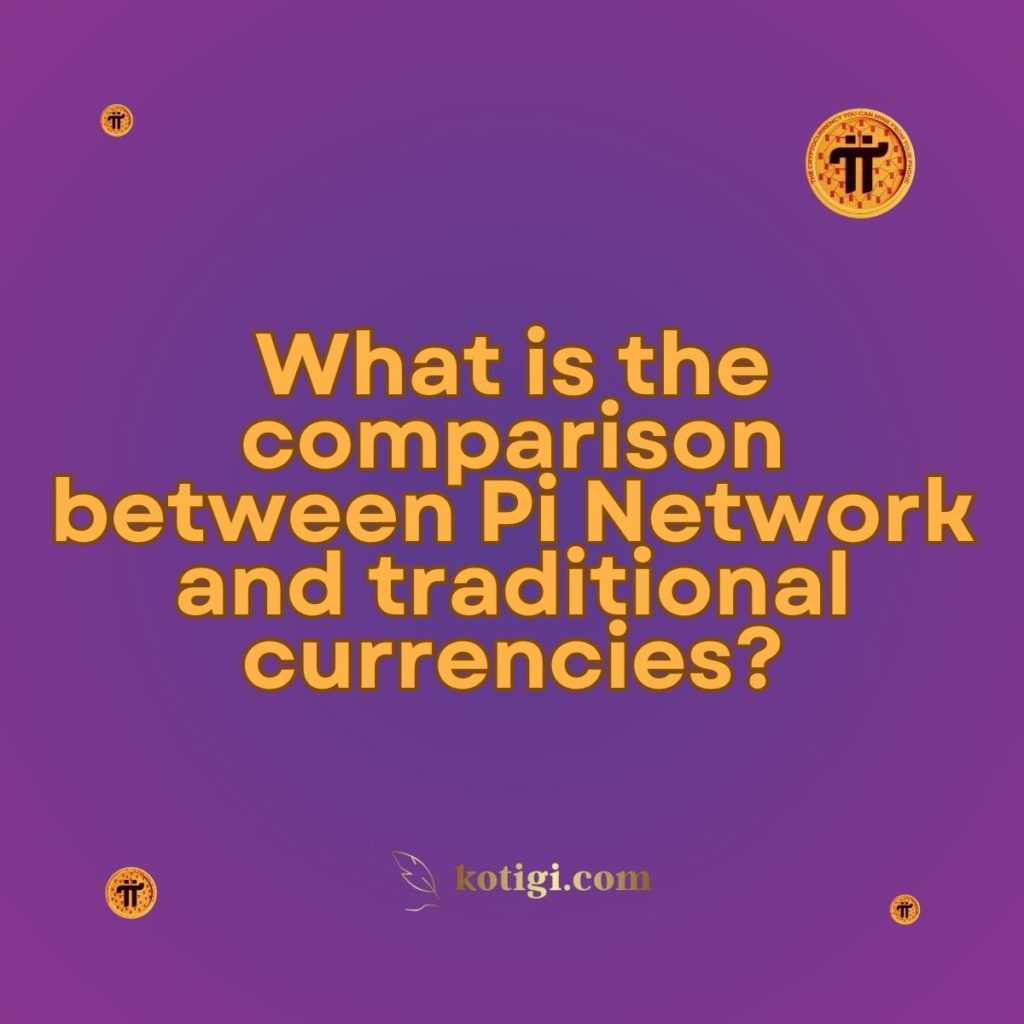
What is the comparison between Pi Network and traditional currencies?
Pi Network and traditional currencies serve as mediums of exchange, but they operate in fundamentally different ways. While traditional currencies rely on central authorities and established banking systems, Pi Network introduces a decentralized, community-driven approach to currency creation and use. This article explores the key differences and similarities between Pi and traditional currencies, highlighting their respective roles in the modern economy.
Introduction
The emergence of cryptocurrencies has sparked significant interest in alternative forms of currency. Among these, Pi Network represents a unique approach, focusing on accessibility and community engagement. In contrast, traditional currencies have long been the backbone of the global economy, governed by central banks and established financial systems. This article examines the fundamental differences and similarities between Pi Network and traditional currencies, covering aspects such as value, regulation, accessibility, and use cases. By exploring these factors, we can better understand the implications of adopting digital currencies like Pi in our increasingly digital world.
Comparison Pi Network vs traditional currencies
Here’s a comparison table highlighting the key differences and similarities between Pi Network and traditional currencies:
| Feature | Pi Network | Traditional Currencies |
|---|---|---|
| Launch Year | 2019 | Varies by country (e.g., USD established in 1792) |
| Authority | Decentralized, community-driven | Centralized, governed by central banks |
| Medium of Exchange | Digital cryptocurrency | Physical and digital currency |
| Mining Method | Mobile mining accessible to all users | No mining; created and regulated by governments |
| Value Determination | Market-driven, community engagement | Backed by government trust and economic stability |
| Stability | Volatile and speculative | Generally stable, influenced by monetary policy |
| Regulatory Framework | Emerging, lacks comprehensive regulation | Well-established with regulations for protection |
| Transaction Speed | Fast transactions via mobile app | Varies; traditional banking can be slow |
| Transaction Costs | Low to no fees expected | Transaction fees apply (bank fees, exchange rates) |
| Accessibility | Highly accessible via mobile app | Widely accessible through banks and ATMs |
| Use Cases | Peer-to-peer transactions, community applications | General trade, savings, and investment |
| Inflation Control | No predetermined supply cap; inflation possible | Central banks control inflation through monetary policy |
| Global Acceptance | Growing but limited | Universally accepted across borders |
Value Proposition
The value of a currency is determined by various factors, including trust, acceptance, and stability. Traditional currencies and Pi Network exhibit different value propositions.
Trust and Acceptance
Traditional currencies, such as the U.S. dollar or the euro, derive their value from the trust placed in the issuing government and the stability of the economy. This trust is reinforced by legal frameworks and regulatory oversight, ensuring that currencies maintain their value and are widely accepted in transactions.
Pi Network’s value proposition relies heavily on community trust and the belief in the network’s future utility. As a relatively new cryptocurrency, Pi’s value is not yet established on the same level as traditional currencies, making it more speculative. Acceptance of Pi as a medium of exchange is still developing, as its ecosystem continues to grow.
Stability and Volatility
Traditional currencies are generally more stable due to government backing and monetary policies designed to control inflation and maintain value. This stability allows for predictable pricing in goods and services, facilitating smooth economic transactions.
In contrast, cryptocurrencies, including Pi Network, often experience high volatility. Factors such as market sentiment, speculation, and regulatory changes can lead to significant price fluctuations. This volatility poses challenges for Pi as it seeks to establish itself as a viable alternative to traditional currencies.
Store of Value
Traditional currencies often function as a store of value, allowing individuals to save and invest over time. However, due to inflation, some traditional currencies may lose purchasing power.
Pi Network, being a relatively new cryptocurrency, has not yet proven itself as a reliable store of value. Its future value depends on user adoption, market dynamics, and the overall success of the ecosystem. Until Pi can establish a stable value, its effectiveness as a store of value remains uncertain.
Regulation and Oversight
Regulation plays a crucial role in the functioning of traditional currencies and impacts the adoption of cryptocurrencies like Pi Network.
Central Authority
Traditional currencies are governed by central banks, which manage monetary policy, interest rates, and currency supply. This centralized control helps maintain stability and public trust in the currency.
Pi Network operates on a decentralized model, where governance is driven by the community rather than a central authority. While this decentralization promotes user participation, it raises concerns about accountability and regulatory compliance. The lack of oversight may hinder Pi’s acceptance by mainstream users and businesses.
Compliance and Legal Frameworks
Traditional currencies are subject to established legal frameworks, ensuring consumer protection, fraud prevention, and anti-money laundering measures. These regulations contribute to the overall stability and reliability of traditional financial systems.
Pi Network faces the challenge of navigating regulatory environments as it seeks to establish itself as a legitimate cryptocurrency. Compliance with existing laws will be crucial for gaining public trust and achieving widespread acceptance. As the cryptocurrency landscape evolves, regulatory scrutiny may increase, impacting Pi’s growth.
Future Regulatory Developments
The future of both traditional currencies and cryptocurrencies will be shaped by regulatory developments. Traditional currencies may face adaptations to comply with evolving financial technologies, while Pi Network and other cryptocurrencies will likely continue to navigate the regulatory landscape to ensure sustainability and growth.
Accessibility and Usability
Accessibility and usability are key factors influencing the adoption of any currency, whether traditional or digital.
Ease of Access
Traditional currencies are widely accessible through banks, ATMs, and various financial institutions. This accessibility allows individuals to engage in economic activities, from everyday transactions to investments.
Pi Network aims to enhance accessibility through its mobile mining app, enabling users to earn Pi coins easily. This user-friendly approach encourages participation from individuals who may not have prior experience with cryptocurrencies. However, widespread acceptance of Pi as a currency is still in development.
Transaction Speed and Costs
Transactions using traditional currencies often involve fees charged by banks or payment processors, which can vary based on the method used (e.g., credit card, wire transfer). While traditional systems provide reliability, they may not be the fastest or most cost-effective options for all users.
Pi Network seeks to address transaction speed and cost through its decentralized platform. The use of a mobile app for mining and transactions can facilitate quicker transfers with minimal fees. However, the actual implementation of these features will determine Pi’s competitive edge in the market.
User Experience
The user experience associated with traditional currencies can vary widely, depending on the financial institution and available services. Users may encounter challenges such as bureaucracy, slow processing times, and limited accessibility, particularly in underserved areas.
Pi Network emphasizes a seamless user experience, focusing on education and engagement. By simplifying the process of mining and transactions, Pi Network aims to create an inclusive environment for all users. The success of this approach will be critical in determining Pi’s long-term viability as a currency.
Economic Models
The economic models underpinning traditional currencies and Pi Network are distinct, impacting their roles in the economy.
Supply Control
Traditional currencies are subject to monetary policies that control supply and demand, helping to maintain stability. Central banks can adjust interest rates, control inflation, and implement quantitative easing measures to influence the economy.
Pi Network employs a unique model for coin distribution through mobile mining. While this model promotes user engagement, it lacks the central control mechanisms seen in traditional currencies. As the supply of Pi coins expands, the potential for inflation and market fluctuations will need to be carefully managed.
Inflation and Deflation
Inflation and deflation affect both traditional currencies and cryptocurrencies. Traditional currencies typically experience controlled inflation through government policies aimed at maintaining economic stability.
In contrast, Pi Network’s inflation rate will depend on user engagement and demand for Pi coins. The lack of a predetermined supply cap raises concerns about inflationary pressures and the potential impact on Pi’s value. Establishing a balanced economic model will be essential for Pi’s success in the long term.
Market Dynamics
Traditional currencies are influenced by macroeconomic factors, including GDP growth, employment rates, and international trade. These factors can drive demand for currencies, impacting their value in the global market.
Pi Network’s market dynamics will be shaped by user adoption, community engagement, and the development of its ecosystem. The success of Pi will rely on creating a robust marketplace that supports diverse use cases, ultimately influencing demand and value.
Future Prospects
The future of currency is evolving, and both Pi Network and traditional currencies face unique challenges and opportunities.
Integration with Digital Economies
Traditional currencies are gradually integrating with digital technologies, leading to the rise of central bank digital currencies (CBDCs). These digital forms of traditional currency aim to combine the benefits of digital transactions with the stability and trust of central banks.
Pi Network has the potential to contribute to this digital evolution by offering a decentralized, community-driven alternative. As digital economies expand, Pi may find its niche by fostering peer-to-peer transactions and engaging users in innovative ways.
Adoption Challenges
Traditional currencies have established infrastructures and user bases, making them challenging to displace. While cryptocurrencies like Pi Network offer innovative solutions, they must overcome hurdles such as regulatory scrutiny, user skepticism, and market volatility to achieve widespread adoption.
For Pi Network, the challenge lies in transitioning from a community-driven project to a widely accepted currency. Building trust and establishing a stable ecosystem will be critical for Pi’s long-term viability.
Vision for the Future
Both Pi Network and traditional currencies must adapt to the changing landscape of the global economy. Traditional currencies will likely continue to evolve in response to technological advancements, while Pi Network has the opportunity to position itself as a valuable alternative for users seeking accessible and inclusive financial solutions.
Conclusion
The comparison between Pi Network and traditional currencies reveals distinct approaches to currency creation and use. Traditional currencies benefit from established trust, regulatory frameworks, and stability, while Pi Network aims to democratize access to cryptocurrency through mobile mining and community engagement. Each model presents unique advantages and challenges that will influence their roles in the modern economy.
As the financial landscape continues to evolve, understanding the differences between Pi Network and traditional currencies is essential for users and investors alike. The future of currency will likely encompass a blend of traditional and digital forms, with projects like Pi Network potentially shaping the way we think about money in an increasingly digital world.
Key Takeaways
- Value Proposition: Traditional currencies rely on government backing and stability, while Pi Network’s value is rooted in community trust and potential future utility.
- Regulation and Oversight: Traditional currencies are governed by central authorities, while Pi Network operates in a decentralized manner, facing regulatory challenges.
- Accessibility and Usability: Traditional currencies are widely accessible through established financial systems, whereas Pi Network promotes accessibility through mobile mining.
- Economic Models: Traditional currencies have controlled supply and inflation, while Pi Network’s model emphasizes community-driven distribution without predetermined limits.
- Future Prospects: Both Pi Network and traditional currencies must adapt to the changing landscape of the global economy, with the potential for integration and innovative solutions.





